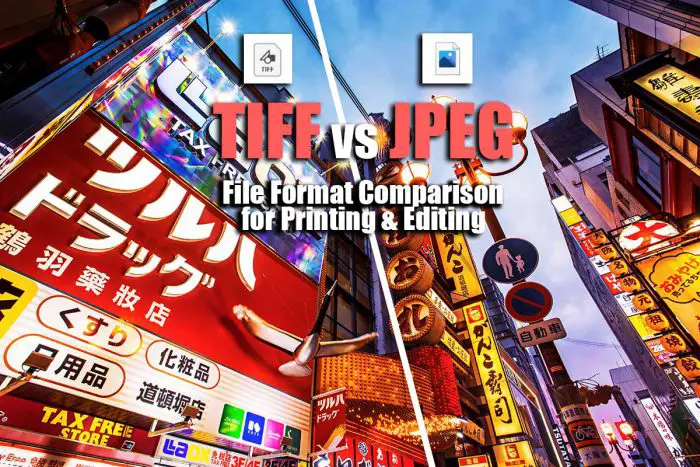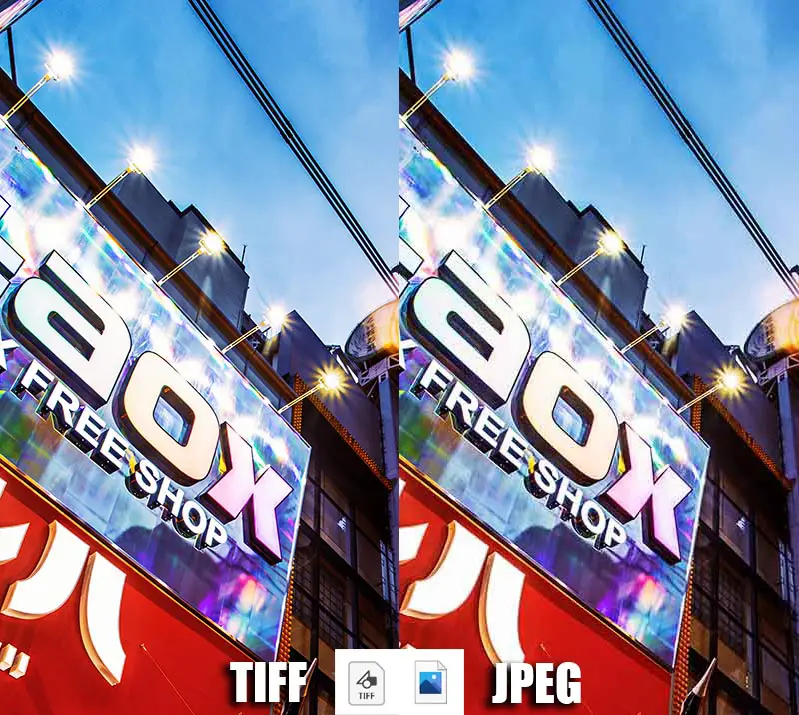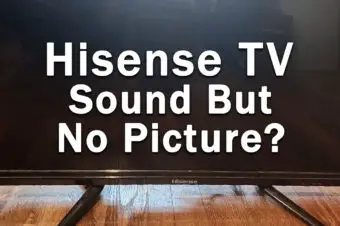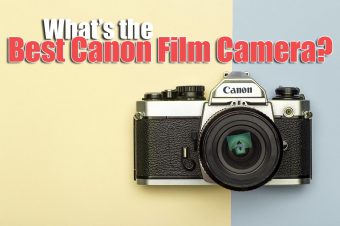When you come to save your photos or other images after editing them, you get the option of saving your files in several formats, including TIFF or JPEG.
These are the two most popular image formats for printing, but does choosing JPEG vs TIFF make any difference?
This article quickly covers the difference between TIFF and JPEG, so that you fully understand why you might want to use TIFF vs JPEG, and means you won’t make a costly mistake when sending your photos to be printed.

TIFF vs JPEG Quick Comparison
The major pros and cons of TIFF, and the pros and cons of JPEG are shown in the TIF vs JPG comparison table below.
| JPG vs TIFF Comparison | ||
|---|---|---|
| Image Quality |
|
|
| File Size |
|
|
| Compression |
|
|
| Support |
|
|
| Suitability for Editing |
|
|
| Layers |
|
|
| Loading Time |
|
|
What is the Difference Between TIFF and JPEG?
The main difference between TIFF and JPEG files is that TIFF files are lossless and so store more image data, resulting in higher quality images, while JPEGs are “lossy” compressed files, throwing out some image data to create a smaller file size, but at the expense of lower image quality.
What are the Advantages of TIFF?

Looking at TIF vs JPEG, the advantages of TIFF (Tagged Image File Format, but also known as TIF) files are based around the fact that they use lossless compression to store image data.
This means that once you save your TIFF file, no data is lost, regardless of how many times you save, or the kind of editing that you do.
They also save layers, such as those that you create in Photoshop, meaning that your edits are non-destructive and can be reversed at a later date if you so wish.
Therefore, TIFF files are perfect to hold complex edits or your photos or images, particularly if you are using Photoshop, as they will hold the widest color and dynamic range of any file format.
In brief, the three advantages of TIFF files are:
- Highest image quality.
- Supports layers for non-destructive editing.
- Lossless compression.
What is Bad About TIFF?
The only real negative of TIFF files is that they produce very large image files. You can easily end up with a file size ranging from 50 MB to several GB’s, once you add a number of layers within Photoshop.
TIFF’s are also less compatible with web galleries like 500px or Flickr, and many of the smaller online photo labs do not accept them to print your photos, as they are too large.
So, the disadvantages of TIFF files are:
- Large file size.
- Not compatible with many web services or printing companies.
What are the Advantages of JPEG?

The real advantage of JPEG is that the files are both very small and compatible with pretty much every web service, printing company or photo viewing program.
JPEG is the standard for most cameras to record their image files, primarily because it is based around lossy compression that removes unnecessary image data to reduce file size.
Comparing TIFF vs JPEG file size, JPG’s are far smaller than TIFF’s, often in the range of 5 – 15 MB, compared with 50+ MB for a TIFF file.
The advantages of JPEG’s are:
- Small file size.
- Wide compatibility.
- Very good trade-off of quality and overall size.
What is Bad About JPEG?
The lossy compression leads to the only negative about JPEG’s – you will see some loss of detail in any JPEG files when compared to the same file saved as a TIFF.
Each time you save a JPEG, the compression algorithm is run again, meaning that successive saves cause the image quality to degrade even further.
This means that if you make an edit, save to JPEG then repeat the process several times, you will eventually reach a point where the image is so degraded that it becomes unusable.
The disadvantage of JPEG’s are:
- Lossy compression means a reduction in image quality with each save.
- No support for layers in Photoshop.
TIFF vs JPG for Printing
You would assume that when comparing TIFF vs JPEG for printing, you should always choose TIFF files, but actually this is not the case in most situations.
Although JPEG files are lossy, they do not lose much image quality if they are only saved once.
Therefore, the best process for the average home user is to first edit your photo as a TIFF file until you reach a final version. Once you are happy, then save the file as a JPEG, which you can then print using your home photo printer, or send to a photo lab.
The advantage of this workflow is that you retain most of the image quality benefits of the TIFF format, but also get the compatibility and small file size of JPEGs.
The only situation where TIFF is better than JPEG for printing is if you are making a very high quality commercial-level of print, such as for a billboard, and need to retain absolute image quality.
For normal home uses, saving to JPEG as the final step and then printing is the best all-round option.
Is TIFF Better Than JPEG?
Although TIFF files contain more image data, and therefore have higher image quality, they suffer from large file sizes and lower compatibility than JPEG’s. TIFF’s are ultimately better for your editing workflows, but JPEG’s are better for printing and for sharing on the web, so which is better will depend on the situation that you want to use it in.
As a direct comparison, I have saved a 100% crop of the same image, first as a TIFF, then as a JPEG that has been through multiple save cycles, so that you can see the image degradation from using JPEG.

Note the loss of image detail in the JPEG file, particularly noticeable in the blue sky around the lights and cables. This is following multiple cycles of saving and closing the file, so would not be something that you are likely to see in practice, unless you use your JPEG files for editing.
If you used your TIFF for editing, before a final save to JPEG, your image would appear as on the left.
Read More:


![[SOLVED] Hisense Roku TV Remote Not Working](https://www.lapseoftheshutter.com/wp-content/uploads/2021/10/Hisense-Roku-TV-Remote-Not-Working-340x226.jpg)



2 Responses
David Miller
Excellent !! Tells me what I need to know re: TIFF vs JPEG. Couldn’t be any clearer!
Tim Daniels
Thanks, David.